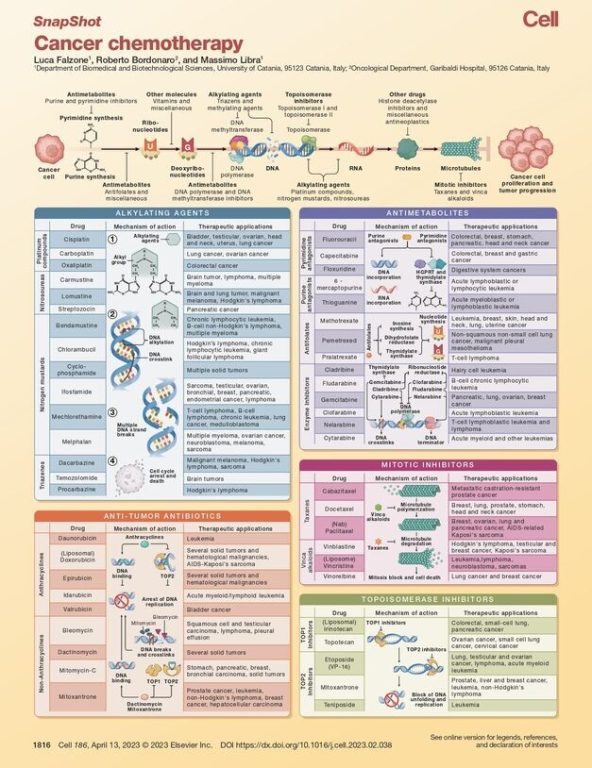
Cancer Chemotherapy: Snapshot
Key concepts for the chemotherapeutic drugs
Antineoplastic Drugs: Key Concepts
Before the mid-20th century, cancer treatment primarily relied on surgery or cautery to remove non-invasive tumors. There were no effective treatments for patients with advanced or metastatic cancer. It wasn't until after World War II that the first drugs with anticancer properties were discovered, revolutionizing cancer treatment. Since the late 1940s, various classes of chemotherapeutic drugs have been employed alone, in combination with other drugs, or alongside surgery and radiation therapy.
Despite advancements in cancer treatment, such as targeted therapy and immunotherapy, chemotherapy remains a vital part of cancer treatment, either on its own or in combination with other therapies. Currently, the Food and Drug Administration (FDA) and the European Medicines Agency (EMA) have approved numerous antineoplastic agents that can halt tumor progression through direct or indirect mechanisms. These drugs are categorized based on their mechanisms of action: alkylating agents, antimetabolites, mitotic inhibitors, topoisomerase inhibitors, and antitumor antibiotics, along with a diverse group of agents with miscellaneous anticancer activities. Chemotherapeutic drugs generally work by preventing nucleotide production, inhibiting key DNA-related enzymes, or blocking essential proteins and structures involved in cancer cell replication.
According to widely recognized guidelines, chemotherapeutic agents can be used as first-, second-, or third-line treatments for various cancers, serving curative, inductive, consolidative, or maintenance purposes, often in combination with other anticancer strategies.
It's important to note that chemotherapy is associated with a wide range of side effects, including gastrointestinal issues (nausea, vomiting, diarrhea, or constipation), bone marrow suppression, weakness, hair loss, mucositis, heart problems, and secondary cancers. These side effects can reduce patient compliance, making it sometimes necessary to administer detoxifying or supportive products, such as vitamins, probiotics, and proper nutrition, to mitigate the negative effects of chemotherapy.
Given the ongoing debate and underappreciation of the selection of appropriate agents in clinical and research settings, this overview aims to provide a general summary of the key chemotherapy drugs currently used in oncology.
Alkylating Agents
Alkylating agents were the first class of antineoplastic drugs discovered, marking a turning point in cancer treatment. This group includes nitrogen mustards, platinum compounds, nitrosoureas, triazanes, and methylating agents, with less commonly used agents such as alkyl sulfonates, ethyleneimines, and methylmelamines. These drugs work by alkylating nucleic acids and proteins, leading to the formation of intra- and inter-strand crosslinks that cause multiple DNA breaks during replication, resulting in cell cycle arrest and cell death. Alkylating agents can be administered via different routes and are used to treat both hematological and solid tumors, including brain tumors, as they can cross the blood-brain barrier.
Antimetabolites
Antimetabolites interfere with DNA and RNA synthesis and include purine and pyrimidine antagonists, which are incorporated into the growing DNA and RNA chains, halting further elongation. They also interfere with enzymes involved in nitrogenous base production, inhibit ribo- and deoxyribonucleotide synthesis, and block various enzymes involved in DNA replication, leading to DNA crosslinks and chain termination. This class also includes DNA methyltransferase inhibitors and other drugs with non-specific mechanisms of action. Antimetabolites can be administered intravenously or orally and are used to treat almost all tumors, particularly hematological cancers.
Mitotic Inhibitors
Mitotic inhibitors are plant-derived agents that induce cell cycle arrest by preventing microtubule formation. This category includes vinca alkaloids and taxanes, which either inhibit tubulin assembly or prevent microtubule disassembly. Both natural and semi-synthetic drugs in this class are used to treat various solid tumors, including breast, lung, ovarian, and prostate cancers, as well as leukemia and lymphoma, through intravenous administration.
Antitumor Antibiotics
Cytotoxic antibiotics comprise anthracycline and non-anthracycline agents. These drugs are administered intravenously and are used to treat both solid and hematological tumors. Anthracyclines work by forming covalent bonds with nucleic acids and topoisomerase II (TOP2), thereby disrupting DNA replication. Non-anthracyclines have different mechanisms; some directly interfere with topoisomerases, while others induce DNA breaks or crosslinks, ultimately hindering DNA replication.
Topoisomerase Inhibitors
Topoisomerase inhibitors include drugs that target both topoisomerase I (TOP1) and topoisomerase II (TOP2), and are derived from plants. Drugs like irinotecan and topotecan inhibit TOP1, preventing DNA unwinding and thus DNA replication. Similarly, etoposide and mitoxantrone target TOP2 to block DNA replication. Inhibition of these enzymes leads to single- and double-strand DNA breaks, causing cell cycle arrest. These drugs can be administered intravenously or orally and are used to treat various solid tumors as well as Hodgkin’s and non-Hodgkin’s lymphomas.
References
- Falzone, L., Salomone, S., and Libra, M. (2018). Evolution of Cancer Pharmacological Treatments at the Turn of the Third Millennium. Front Pharmacol 9, 1300.
- EMA. Medicines: European Medicines Agency. https://www.ema.europa.eu/en/medicines/field_ema_web_categories%253Aname_%20field/Human.
- US FDA. Oncology (Cancer) / Hematologic Malignacies Approval Notifications. https://www.fda.gov/drugs/resources-information-approved-drugs/oncology-cancer-hematologic-malignancies-approval-notifications.
- ESMO. Guidelines. https://esmo.org/guidelines.
- ASCO. Guidelines, Tools, & Resources. https://old-prod.asco.org/practice-patients/guidelines.
- Kanarek, N., Petrova, B., and Sabatini, D.M. (2020). Nature 579, 507–517.
- McQuade, J.L., Daniel, C.R., Helmink, B.A., and Wargo, J.A. (2019). Lancet Oncol 20, e77–e91
Source
https://doi.org/10.1016/j.cell.2023.02.038
Click here to download the PDF
